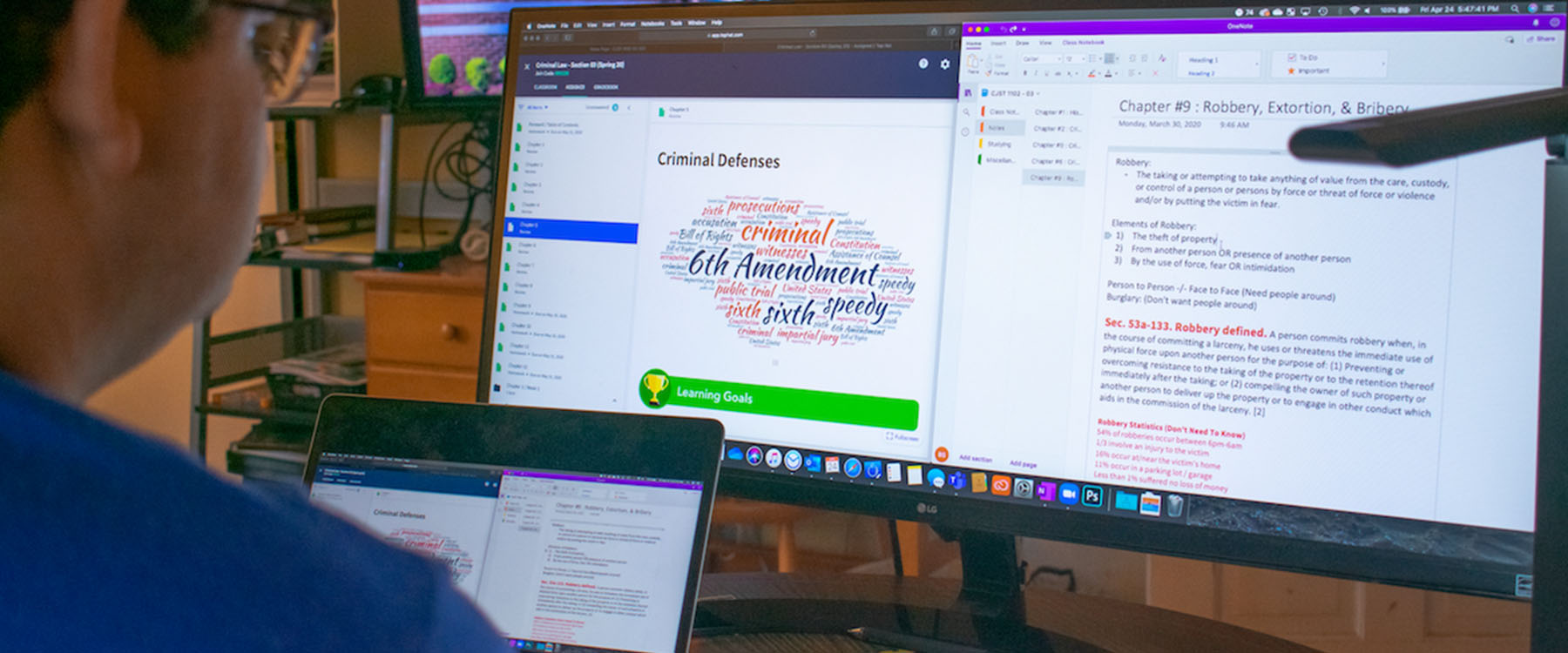Simplifying the Switch to Online Teaching with Interactive Content and Courseware
$150
students saved on course materials per semester
700
students taught each year
7%
average increase in quiz scores after adopting Top Hat

The Challenge
Transitioning to online teaching amidst campus closures due to COVID-19
Daniel Maxwell is not your typical educator. Before he joined the Criminal Justice Department at the University of New Haven (UNH) he was a law enforcement officer for 25 years. Because of this unique background, Maxwell brings a distinct approach to teaching. He draws regularly on his police experience, sharing anecdotes from the cases he’s worked to infuse his presentations with real-world examples. Always mindful of the student experience, he also pays close attention to student feedback to ensure learners connect with the material.
From the results of discussions and surveys, Maxwell realized students were struggling with a disjointed learning experience: the material he taught in class didn’t easily match up with the content in the course textbook, which provided little value to students but at a high cost. “Textbooks are too expensive,” Maxwell says of the $200 tomes he previously assigned. “Students will do anything to get out of buying them and if they do buy them they won’t use 95 percent of the book.” He needed to ensure he had the right materials in place to augment his personal, qualitative approach to instruction.
Maxwell decided to author a textbook with Top Hat for his Criminal Justice course. He wanted to create more relevant content with built-in assessments to make reading assignments before and after class more engaging, insights into which could be leveraged for discussions during class time. The ‘do-it-yourself’ approach also didn’t hurt in that he was able to save learners upwards of $150 per semester on course materials.
Maxwell was never a fan of the sage-on-stage, Powerpoint-driven model of teaching. Top Hat allowed him to create a flipped classroom, which gave him the versatility to teach the same way in-person as online. Even as a relatively new Top Hat customer—first employing the active learning solution in his fall 2019 course—Maxwell was especially thankful for the platform’s ease of use and utility when COVID-19 forced campuses closed in early 2020.
The Solution
Original, customizable course materials kept learning consistent and engaging
Prior to campus closures due to COVID-19, Maxwell had great success flipping his classroom. Instead of using slides or presenting new content during class meetings, he assigned interactive textbook readings prior to class with pertinent details highlighted to focus his students. He typically facilitated a discussion in class based on student responses to pre-class textbook assignments. Maxwell was inspired by the lively conversations he was able to have with students and he attributed the high engagement levels to their preparation before class, as well as the additional Top Hat questions and discussions he asked in real time.
When the COVID-19 pandemic forced in-person classes closed at UNH, Maxwell felt confident in making the transition to online learning, knowing that his students would continue to get the high quality experience they deserved. The only change he needed to make was shifting his in-person class meetings to virtual ones using a video conference solution. “I wanted to provide some structure for them,” says Maxwell of his students, some of whom are now at home and as far afield as China or India. “At least for an hour, they all come to a familiar place.”
Maxwell continued to engage students in remote class sessions using Top Hat questions and also started leveraging additional platform features. The ability to monitor students’ completion of the digital textbook readings before class allowed him to gauge learner progress—something that has become even more important in the switch to remote teaching. Similarly, the ‘progress bar’ came in handy for keeping an eye on student participation during in-class questions.
“My classes are now doing better by a full point across the board. That is no fluke. This stuff works.”


The Results
Top Hat boasted the tools needed to teach a course the same way—in person or remotely
In this time of vast disruption, Maxwell and his students are grateful that the learning experience has continued uninterrupted. “Everything is the same, even the class time,” says Maxwell. Due to the customizable nature of an interactive Top Hat textbook, he’s even been able to keep the material current, asking questions like ‘What do you think will happen to crime rates amidst the pandemic?’
In his Criminal Justice course, Maxwell holds four quizzes a semester, worth 15 points each. Recently, he reviewed the scores for those quizzes after adopting Top Hat, comparing them to student grades for the past five years. “It’s the same material, the same quiz questions, same everything,” he says. “However, my classes are now doing better by a full point across the board. That is no fluke. This stuff works.”
Qualitative student feedback on the use of Top Hat, which he collects through polls, surveys and discussion questions, has also been “overwhelmingly good”—an important indication for a professor who cares deeply about the learner experience. “The technology used in this course has allowed me to learn in a better way than in any other course I have taken,” says Criminal Justice major Scott Bauman. “It provides a tool for the professor to get active feedback from us in order to keep us engaged and to foster an open and respectful discussion.”








